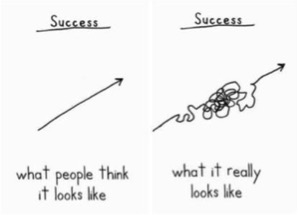- Home
- About Us
- The Team / Contact Us
- Books and Resources
- Privacy Policy
- Nonprofit Employer of Choice Award

 When you look at career paths, you might think they are linear, but in reality, they can take many turns.
When you look at career paths, you might think they are linear, but in reality, they can take many turns.

(PHOTO CREDIT: Demetri Martin, “This is a Book“)
This drawing fittingly explains the reality of what career success will look like for many of us in the new age of employment. It is well-known that we have moved from the days of one career to having multiple careers in our lifetime – and this applies to all industries and sectors.
I recently had a conversation with someone who has worked with hundreds of executives in the charitable, government and social profit sectors. She was adamant that the successful leaders of the future will not be the ones with the most knowledge, the most skills or the most experience, but with the strongest ability to adapt and change. This requires gathering a variety of skill sets and perspectives – the type you can gain from shifting career paths.
In that case, experiencing multiple careers is not a bad thing – it can actually work in your favour and prepare you for the employment landscape of the future.
After 8 years working at an internationally known charity, being provided opportunities to advance into new roles, and ending up in the helm of the fundraising department, overseeing a team of 8 people and raising over $8M annually - I decided to take on the role of Executive Director of a much smaller (or as I prefer to say, small and mighty) organization.
How to decide if a move like this is right for you?
My current seat is within an organization that I volunteered with intensely for eight years before joining as the Executive Director. I felt deeply invested their success before starting. While this move was a difficult choice because I felt very much fulfilled and connected to my last shop; the decision to move ultimately came down to a matter of following my gut and asking some key questions to engage my brain:
Asking yourself questions like this will serve as a self-interview, making sure you are listening to your heart and your head in the right quantities.
What is the difference between heading up fundraising at a large organization and leading the charge at a smaller organization?
If you are considering such a move, there are some important differences between large and small organizations, and between lead fundraising roles versus lead management roles, which you should be aware of. The following tips may help you prevent total culture shock when you make the leap:
Strategies to shifting into an Executive Director role?
Here are four key things I learned making the shift to being an Executive Director:
Making a career shift can be scary, but can stretch your perspective, challenge you to build new skills and be a wonderful stage in your journey. There is no one right way to do things – it depends on your personal definitions of success. Wherever you go, bring your best self, develop positive reputation and stay in touch with the people who matter – that is always important. Besides, this decision is never final – you can always go back the other way, now armed with some new skills and a broader lens that you bring with you.
Rickesh passionately believes that every donor deserves to feel excellent about giving, and that the duty of a fundraiser is to bring passion towards enhancing the donor experience every day. He is adamant about always putting people first, then process, and that fundraisers, charities and social profit groups should not be afraid to have a personality. Rickesh is the Executive Director at Future Possibilities for Kids, where they provide leadership and life skills development programs for children and youth from underserved communities. Prior to this, Rickesh was the Director, Campaign at United Way York Region, leading an $8M annual fundraising campaign. He is on the Board of Directors for the Association for Fundraising Professionals of Greater Toronto and is the lead organizer of Be Good Be Social York Region, a conference promoting social media for social good.